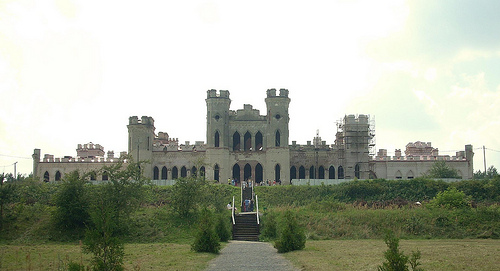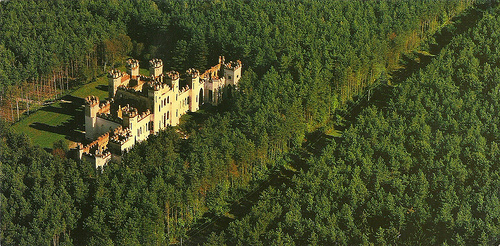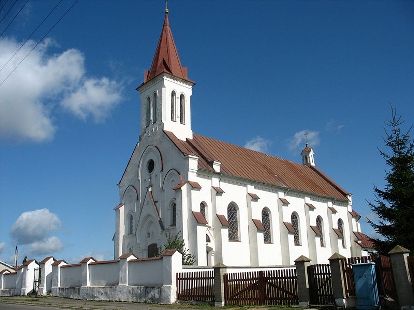

Location: Kosava, Ivatsevichy Raion, Brest Province Map
Kosava is a historic Belarusian town in the Ivatsevichy Raion, Brest Province of Belarus. A nearby town called Mereczowszczyzna is the birthplace of Tadeusz Kościuszko. Kosava is the birthplace of Rabbi Avrohom Yeshaya Karelitz. Nearby is the ruined castle of Kosava, built by the Pusłowski family in 1830, and a replica of the house of Tadeusz Kościuszko in Mereczowszczyzna.
The first settlements on the territory of Kossovo arose in the X-XI centuries. The ancient settlement of the X-XII centuries, which was explored by historians Yuri Kukharenko, Leonid Pobal, Pyotr Lysenko and Pavel Rapaport. In written sources Kosava for the first time is mentioned in 1494 in the charter of the Grand Duke Alexander, who gave it to Marshal Khrapitovich. In 1510 the Grand Duke Zhigimond old issued a letter of commendation and holding fairs in the city. At this time, Kossov or Kosava became the center of the district, but according to the administrative territorial reform of 1565-1566 the city joined the Novgorod province.

Kosava Castle also known as Puslowski Palace is a ruined and abandoned neo- Gothic residence in Kosava Belarus. Puslowski Palace is occasionally referred as a Kosava Castle due to its location and stylized pseudo- Gothic Medieval appearance. Puslowski Palace was constructed in 1830 by the orders of graf Wandalin Puslowski and under design of architect Frantisek Yascholda with help of V. Marcone. It contains 132 rooms and 12 towers. Each tower represents a month of a year. Central four towers represent four bread months of the year: May, June, July and August. These towers are arranged in a way that every year sun illuminates all the rooms inside one particular tower for two and a half days. Internal passages, layout of the halls and windows allows sun rays to penetrate all corners of the building. Residents of the Kosava Castle celebrated these days by decorating the interior and holding various events on these particular days.
Eccentricities of the Puslowski noble family didn't end here. One of the legends claim that the ceremonial Central Hall of the Kosava Castle had a glass floor in the center with an aquarium installed underneath. Various fishes lived here and were the center of the lavish balls that once were held here. Another legend claims that Puslowski bought a lion who was allowed off his chain by night. All the private rooms were locked for the night and a lonely lion would prowl the area attacking all the intruders and killing them on the spot.
However the most popular legend that surrounds Kosava Castle is that it had an underground tunnel constructed between Puslowski estate and the residence of another noble Sapieha family in Ruzhany. This myth claims it was 25 km long and was wide enough for a carriage to pass through. It is said that both families visited each other regularly using this passage. However no physical evidence were ever recorded proving this theory.
Unfortunately Puslowski family lost their claims to the Kosava Castle. It happened in a classic Puslowski manner. Builder's grandson lost his possessions playing cards.
After Polish uprising against Russian rule known as January Uprising (1863) have failed Kosava Castle was turned to a family of Russian aristocratic Trubetskoy family. During World War I and World War II the residence was badly damaged during fighting and finally abandoned. Some blamed the damage on careless German soldiers, while other believe it was partisans burned it in an attempt to kill Germans sleeping inside.

Tadeusz Kosciuszko's house is a replica of the original residence where Tadeusz Kościuszko was born. He became famous as a Polish hero who lead failed attempt to gain independence for Poland from the Russian Empire. Original Tadeusz Kosciuszko's house was made of wood and over course of decades of neglect and elements it fell apart. Nevertheless its drawings were preserved. It gave modern historians an idea of its appearance. Reconstructed Tadeusz Kosciuszko's house was opened on September 23, 2004. It was on this location Tadeusz Kosciuszko was born on February 4, 1746. It was also the residence where he grew up. He led a Polish national rebellion against the Russian Empire. Uprising failed and he was forced to move to the United States where he served with distinction during the Revolutionary War for American independence. His home however stayed intact despite history of Kosava's most famous trouble maker. Unfortunately it changed with the start of World War II. Tadeusz Kosciuszko's house was burned down during hostilities. Museum of Tadeusz Kosciuszko's house is roughly divided into two sections. One portion is dedicated to historic period with recreated interior of rooms as they existed back in the 18th century. Another part of the museum is dedicated to the archeological finds that were discovered on an original site of the Tadeusz Kosciuszko's house. Today the museum is also a popular location for weddings that are held on weekends.

Catholic Church of Holy Trinity is a Roman Catholic church in Kosava. It is a simple, yet elegant building that is open to the public. Church of Holy Trinity belongs to the Pruzhany deanery of Diocese of Pinsk. Today it is protected by the government and listed on a list of Cultural Properties of Belarus. This neo- Gothic cathedral is the largest religious building in the town. Original wooden Catholic Church was constructed in 1626. Most famous son of Kosava, Tadeusz Kościuszko, was baptized here on 12 February 1746. Unfortunately the original structure was not preserved. In 1877- 78 wooden Church of Holy Trinity was demolished and a new stone structure of Catholic Church of Holy Trinity was constructed in its present appearance. Money for the reconstruction was donated by the local noble family of Puslovsky or Puslowski clan (Count Vandalin Puslovsky). Church is a simple rectangular in layout with a single nave. The main facade is dominated by a tetrahedral bell tower. The interior of Holy Trinity is fairly simple on the inside. The main altar has several icons including an icon of "Mother of God of Mercy", the most venerated icon in the church.